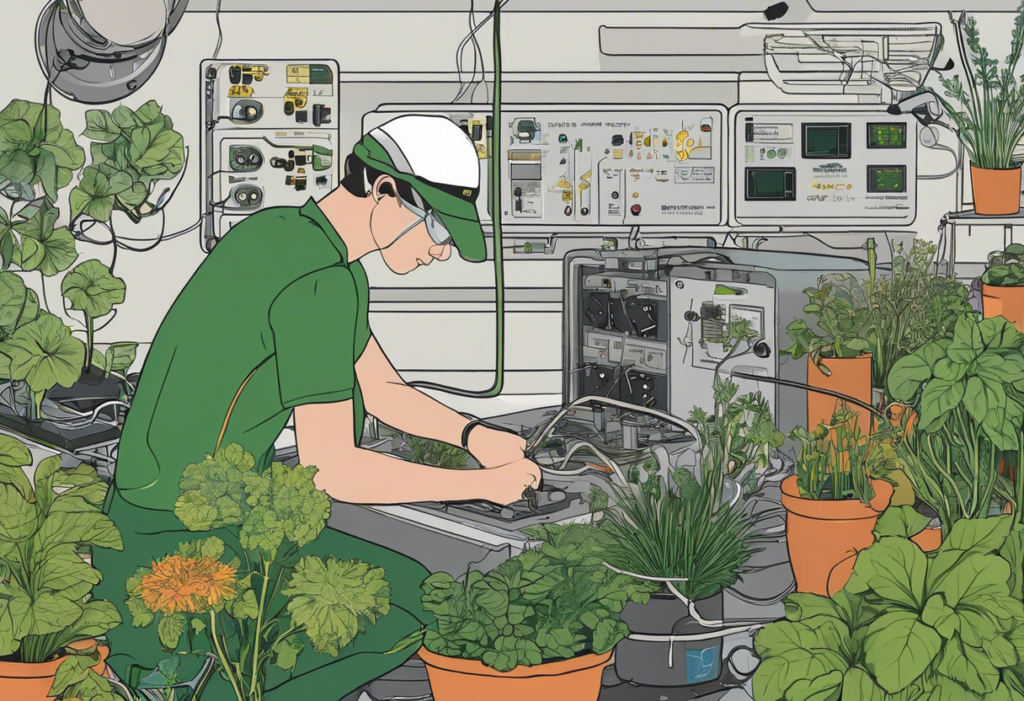The Ultimate ELECTROCULTURE Video Course -Electroculture is a holistic and innovative approach to agriculture that harnesses the power of electricity to enhance plant growth and productivity. This section of the course will provide a comprehensive introduction to the principles and techniques of electroculture, exploring how this cutting-edge methodology can revolutionize traditional farming practices.
- Benefits of Electroculture:
- Increased crop yields
- Reduced water consumption
- Enhanced nutrient absorption
- Improved plant health and resilience
- Fundamental Concepts:
- Understanding the role of electricity in plant growth
- Exploring different electroculture methods such as electrostimulation and electroculture substrates
- The science behind electroculture and its impact on crops
- Tools and Equipment:
- Overview of essential tools required for electroculture practices
- Selection of appropriate equipment for different farming scales
- Maintenance tips to ensure optimal performance of electroculture devices
- Practical Applications:
- Case studies illustrating successful implementation of electroculture in various agricultural settings
- Tips for integrating electroculture techniques into existing farming systems
- Potential challenges and how to overcome them in electroculture practices
By delving into the fundamentals of electroculture and exploring its practical applications, participants will gain valuable insights into this emerging field and learn how to leverage the power of electricity to transform their agriculture practices.
Get This Course : Click Here
Benefits of Electroculture Farming
- Increased crop yields: Electroculture farming has shown promising results in increasing crop yields. By stimulating plant growth through electric currents, farmers can potentially harvest more produce per acre of land.
- Reduced pest control needs: One of the advantages of electroculture farming is its ability to repel pests naturally. Electric currents can deter insects and other pests, reducing the need for chemical pesticides.
- Enhanced soil health: The use of electric currents in electroculture farming can improve soil health by promoting microbial activity and nutrient uptake by plants. This leads to healthier soil and better crop growth.
- Water conservation: Electroculture farming has the potential to reduce water usage in agriculture. By improving plant growth and nutrient absorption, crops may require less water to thrive, resulting in more efficient water usage.
- Sustainable farming practices: Electroculture farming promotes sustainable agriculture by reducing the reliance on chemical inputs such as fertilizers and pesticides. This can lead to more environmentally friendly farming practices.
- Improved plant resilience: Electric currents used in electroculture farming can boost plant immune systems, making them more resilient to environmental stressors such as disease, drought, and extreme temperatures.

By harnessing the benefits of electroculture farming, farmers can potentially increase their yields, reduce their environmental impact, and improve the overall sustainability of their agricultural practices.
Understanding the Basic Principles of Electroculture
Electroculture is a fascinating approach to boosting plant growth through the utilization of electricity in agriculture. Here are the fundamental principles to grasp:
- Electrical Stimulation: By applying low levels of electricity to plants, the natural growing processes can be enhanced, leading to improved yield and quality.
- Root Development: Electricity stimulates root growth, enabling plants to better absorb nutrients and water from the soil.
- Ion Movement: The introduction of electricity facilitates the movement of ions in the soil, promoting better nutrient uptake by the plants.
- Microbial Activity: Electrical currents can influence the activity of soil microbes, which play a crucial role in nutrient cycling and plant health.
- Water Conservation: Through electrostimulation, plants may become more efficient in water usage, potentially reducing water requirements for agriculture.
When implementing electoculture techniques:
- Safety Precautions: It is vital to follow safety guidelines to prevent electrical hazards and ensure the well-being of the operator and plants.
- Proper Equipment: Employing the right equipment, such as electrodes and power sources, is essential for effective electroculture practices.
- Monitoring and Adjusting: Regularly monitoring plant responses to electrical stimuli and adjusting the parameters accordingly can optimize results.
- Experimentation: Given the innovative nature of electoculture, experimenting with different approaches and setups can lead to breakthroughs in plant growth.
Understanding these foundational principles is crucial for harnessing the full potential of electoculture and reaping its benefits in agricultural practices.
Chapter 1: Importance of Gardening

- Gardening is not only a hobby but also a rewarding activity that promotes mental and physical well-being.
- It allows individuals to connect with nature, reduce stress levels, and improve mood.
- By cultivating plants, gardeners contribute to a healthier environment by enhancing air quality and biodiversity.
- Gardening also provides a sense of accomplishment and pride as individuals witness the fruits of their labor blooming.
- Growing one’s food through gardening can lead to a more sustainable and self-sufficient lifestyle.
- Gardening offers an opportunity for relaxation and mindfulness, promoting a balanced and tranquil state of mind.
- It educates individuals about the importance of conservation and the value of nurturing living entities.
- Gardening can also be a social activity, bringing communities together and fostering relationships through shared interests.
- Engaging in gardening can improve physical health by encouraging movement, flexibility, and strength through various tasks.
Chapter 2: Understanding the Concept of Electroculture

Understanding the concept of electroculture is essential for anyone interested in harnessing this innovative agricultural technique. In this chapter, learners will delve into the fundamental principles that underpin electroculture and its potential benefits for plant growth and health. Key points covered in this section include:
- History of Electroculture: Exploring the origins and evolution of electroculture practices over time.
- Principles of Electroculture: Understanding the science behind how electricity can enhance plant growth and increase crop yields.
- Benefits of Electroculture: Discovering the potential advantages of electroculture, such as improved soil fertility, pest control, and drought resistance.
- Types of Electrodes: Learning about different types of electrodes used in electroculture applications and their functions.
- Application of Electric Current: Exploring the various methods of applying electric current to plants and soil for optimal results.
By gaining a comprehensive understanding of these foundational concepts, participants will be better equipped to implement electroculture techniques effectively in their own agricultural practices. This knowledge will serve as a solid foundation for the practical aspects of electroculture covered in subsequent chapters, providing a robust framework for successful integration of electroculture methods in farming and gardening.
Chapter 3: Introduction to Electroculture Equipment

When delving into the realm of electroculture, it is vital to have a thorough understanding of the equipment involved. Here is a detailed overview of the essential electroculture equipment to kickstart your journey into this innovative agricultural practice:
- Electrodes: Electrodes are pivotal in electroculture systems as they are responsible for delivering the electric charge to the plants or the soil. These electrodes can vary in material, size, and shape depending on the specific application.
- Power Source: A reliable power source is essential to supply the necessary electric current for electroculture operations. This can range from batteries for smaller setups to more robust power supplies for larger agricultural plots.
- Controllers: Controllers play a crucial role in regulating the electric current flow to ensure the optimal conditions for plant growth. These devices allow for precise adjustment of voltage, current, and frequency according to the requirements of the plants.
- Monitoring Instruments: Monitoring instruments such as multimeters and data loggers are utilized to keep track of various parameters like voltage, current, and soil moisture levels. These instruments provide valuable insights into the effectiveness of the electroculture system.
- Grounding Materials: Proper grounding is essential in electroculture to ensure safety and efficient distribution of electric currents. Various grounding materials like copper rods or conductive plates are used to establish a secure connection with the earth.
By familiarizing yourself with these essential electroculture equipment components, you can set a strong foundation for implementing electroculture practices effectively and maximizing the benefits for your crops.
Chapter 4: Selection of Copper Wire for Antenna

When selecting copper wire for an antenna in your electoculture setup, there are several key factors to consider to ensure optimal performance:
- Wire Gauge: The gauge of the copper wire affects its resistance and ability to carry electrical signals. Thicker wire, with a lower gauge number, offers less resistance and is better suited for long-range transmission.
- Copper Purity: High purity copper wire is more conductive and less prone to corrosion, ensuring efficient signal transmission. Look for oxygen-free copper wire for the best results.
- Flexibility: Consider the intended application of the antenna when choosing the flexibility of the copper wire. A more flexible wire may be easier to work with for certain designs.
- Length: The length of the copper wire used in the antenna can impact its resonant frequency and overall performance. Ensure the wire length aligns with the desired frequency range of your electoculture system.
- Insulation: Insulation is essential to protect the copper wire from environmental factors such as moisture and temperature changes. Choose wire with durable insulation to prolong the lifespan of your antenna.
- Budget: Consider your budget when selecting copper wire for your antenna. While high-quality copper wire may be more expensive, it can offer better performance and longevity.
By carefully considering these factors and selecting the right copper wire for your electoculture antenna, you can optimize the efficiency and effectiveness of your system.
Chapter 5: Electroculture Antenna Design

In this chapter, participants will delve into the intricate world of electroculture antenna design. Antennas serve as a crucial component in electroculture, acting as receptors to harness and channel electromagnetic energy into the soil.
Key topics covered in this chapter include:
- Understanding the principles behind antenna design in electroculture systems
- Different types of antennas commonly used in electroculture applications
- Factors to consider when designing an electroculture antenna for optimal performance
- Practical design tips and guidelines for constructing effective antennas
- Troubleshooting common issues in antenna design and implementation
Participants will gain valuable insights into the design considerations that can significantly impact the efficiency and effectiveness of electroculture systems. By mastering the art of antenna design, learners will be better equipped to maximize the potential of electroculture in enhancing plant growth and soil health.
“Designing an effective electroculture antenna requires a combination of technical knowledge and practical skills to ensure optimal performance in harnessing electromagnetic energy for agricultural use.”
Chapter 6: Electroculture Antenna DIY Without Wooden Stack

In this chapter, learners will delve into the process of creating an Electroculture antenna without the use of a wooden stack. This method offers an alternative approach for individuals who may not have access to wooden materials or prefer a different setup altogether. The DIY process outlined in this section is designed to be practical and accessible for enthusiasts looking to experiment with Electroculture techniques.
- The first step involves gathering the necessary materials, which typically include copper wire, insulated wire, connectors, and a PVC pipe.
- Next, learners will need to determine the appropriate dimensions for their antenna based on the desired electromagnetic field strength and coverage area.
- The copper wire is then wrapped around the PVC pipe in a specific pattern to create the antenna structure. This process requires precision and attention to detail to ensure optimal performance.
- Once the antenna structure is assembled, the insulated wire is attached to complete the circuit and allow for the flow of electricity.
- It is essential to test the antenna setup to ensure that it is functioning correctly before incorporating it into an Electroculture system.
By following the step-by-step instructions provided in this section, learners will be able to create a functional Electroculture antenna without the need for a wooden stack. This DIY approach offers flexibility and customization options for enthusiasts looking to explore the possibilities of Electroculture techniques.
Chapter 7: Electroculture Antenna DIY With Wooden Stack

- To create your electroculture antenna using a wooden stack, follow these steps:
- Gather Materials: Collect wooden stakes or rods, wire, and insulators.
- Choose a Location: Find a suitable spot with good sunlight exposure.
- Prepare the Ground: Ensure the area is clear and free of debris.
- Drive Stakes: Insert the wooden stakes into the ground in a straight line.
- Connect Wire: Attach the wire to each stake using insulators to keep it in place.
- Secure the Connection: Make sure the wire is tightly secured to each stake.
- Test the Antenna: Check the conductivity by using a multimeter or other testing equipment.
- Adjust as Needed: Fine-tune the positioning and connections for optimal performance.
Remember, the wooden stack antenna is a simple and effective way to enhance your electroculture setup. Experiment with different configurations and designs to find what works best for your plants and soil.
Chapter 8: Electroculture on Cactus Garden

In Chapter 8 of the video course, viewers will delve into the fascinating realm of applying electroculture techniques to a cactus garden. Cacti are known for their resilience and unique watering needs, making them an ideal candidate for experimentation with electroculture methods.
Key topics covered in this section include:
- Understanding the specific requirements of cacti in terms of soil composition and watering frequency.
- Exploring how electroculture can enhance the growth and health of cacti by promoting nutrient uptake and water retention.
- Practical demonstrations of setting up an electroculture system in a cactus garden, tailored to the needs of these desert plants.
- Tips and tricks for maintaining the electroculture setup and monitoring its impact on cactus growth over time.
One of the highlights of this section is the in-depth guidance on adjusting electroculture parameters to suit the arid conditions typical of cactus habitats. Viewers will learn how to fine-tune electrical stimulation to maximize the benefits for their cacti without risking overstimulation. By combining traditional cactus care techniques with innovative electroculture methods, participants will gain valuable insights into sustainable gardening practices that can yield impressive results.
Join us in Chapter 8 as we unlock the potential of electroculture in transforming cactus gardens into thriving oases of greenery.
Chapter 9: Results of Electroculture on Cactus Garden

Electroculture techniques were meticulously applied to a cactus garden, yielding intriguing results that showcased the potential of electromagnetism on plant growth. Here are the key findings from the experiment:
- Enhanced Growth: The application of electromagnetism on the cactus garden resulted in visibly enhanced growth patterns. The plants exhibited increased height, fuller foliage, and overall healthier appearances compared to control groups.
- Improved Resistance: Electroculture treatment appeared to boost the resistance of cacti to various environmental stressors. The plants showed resilience against common challenges such as pests, diseases, and adverse weather conditions.
- Accelerated Flowering: One of the most striking outcomes was the accelerated flowering of the cacti. Electromagnetic stimulation seemed to stimulate the plants’ reproductive processes, leading to earlier and more abundant blooms.
- Increased Fruit Yield: In addition to enhanced flowering, the cacti also produced higher fruit yields when subjected to electroculture techniques. This phenomenon indicates a potential for improved crop productivity in agricultural settings.
- Nutrient Absorption: The experiment hinted at improved nutrient absorption by cacti exposed to electromagnetism. This finding suggests that electroculture could play a role in optimizing plant nutrient uptake and utilization.
- Overall Health Benefits: The cacti in the electroculture-treated garden exhibited an overall healthier state compared to their counterparts. The plants appeared more vigorous, with stronger root systems and better overall vitality.
These results offer valuable insights into the potential benefits of electroculture in promoting plant growth and vitality, especially in challenging environments. Further research is warranted to fully understand the mechanisms behind these effects and optimize electroculture techniques for broader agricultural applications.
Chapter 10: Case Study – Arrowhead Plant Growth

In this case study, the focus is on the application of electroculture techniques to enhance the growth of Arrowhead plants. The Arrowhead plant, also known as Syngonium podophyllum, is a popular houseplant known for its arrow-shaped leaves and ease of care. By implementing electroculture methods, researchers were able to observe significant improvements in the growth and overall health of the Arrowhead plants.
- Electroculture Setup:
- Electrodes were strategically placed in the soil around the plant, creating an electric field that facilitated nutrient absorption and root development.
- The use of low-voltage electricity was carefully regulated to ensure that the plants received optimal stimulation without any harm.
- Observations and Results:
- Researchers noted increased foliage density and overall plant size in the Arrowhead plants subjected to electroculture.
- Root systems appeared to be more robust and better developed, leading to improved water and nutrient uptake.
- The plants exhibited enhanced resistance to pests and diseases, indicating a boost in their overall resilience.
- Implications and Future Research:
- The success of electroculture in promoting the growth of Arrowhead plants opens up possibilities for its application in commercial plant cultivation.
- Further research could delve into the specific mechanisms behind how electroculture enhances plant growth and how it can be utilized on a larger scale.
This case study serves as a compelling example of how electroculture techniques can be effectively applied to optimize plant growth and health, offering exciting prospects for the future of agriculture and horticulture.
Chapter 11: Case Study – Various Pumpkin Plant Growth

In this chapter, the course delves into a detailed case study focusing on the growth of pumpkin plants utilizing electroculture techniques. The various stages of pumpkin plant growth are observed and analyzed to showcase the potential benefits of integrating electroculture into agricultural practices. Here are some key points highlighted in the case study:
- Seed Germination: The study includes observations on how electroculture methods affect the germination rate of pumpkin seeds. The process of seed germination is crucial for the overall growth and yield of the plant.
- Seedling Development: The course explores the impact of electroculture on the early stages of pumpkin plant growth. It examines factors such as root development, stem growth, and leaf formation during the seedling stage.
- Vegetative Growth: The case study investigates how electroculture techniques influence the vegetative growth phase of pumpkin plants. This includes assessing factors like foliage density, branching patterns, and overall plant health.
- Flowering and Fruit Production: The course also examines how electroculture methods can potentially enhance the flowering and fruiting stages of pumpkin plants. It explores aspects such as flower formation, pollination, and fruit development.
- Yield and Quality: By monitoring the entire growth cycle of the pumpkin plants, the case study aims to provide insights into the potential increase in yield and improvement in the quality of the produce through electroculture practices.
This case study serves as a practical demonstration of the application of electroculture in agriculture, specifically focusing on pumpkin plant growth. By understanding the impact of electroculture on various stages of plant development, farmers and agricultural enthusiasts can explore innovative ways to optimize crop production and enhance crop quality.
Chapter 12: Electroculture Insights for Sustainable Farming

- Electroculture offers innovative techniques for sustainable farming practices.
- By using electricity to stimulate plant growth, farmers can increase yields and reduce reliance on harmful chemicals.
- Understanding the principles of electroculture can lead to more efficient and environmentally friendly farming methods.
- Farmers can learn how to harness the power of electricity to enhance soil fertility and crop production.
- Electricity can promote the uptake of nutrients by plants, leading to healthier and more robust crops.
- Electroculture can help farmers reduce water usage by increasing the efficiency of irrigation systems.
- By implementing electroculture practices, farmers can potentially reduce their carbon footprint and contribute to a more sustainable agricultural industry.
“Electroculture insights provide valuable knowledge for farmers looking to improve the health and productivity of their crops.”
- By incorporating electroculture techniques into their farming methods, growers can take significant steps towards sustainable and environmentally conscious agricultural practices.
Creating Sustainable Farming Practices with Electroculture
Electroculture has emerged as a promising solution for creating sustainable farming practices. By utilizing the principles of electrophysiology, this innovative technique aims to enhance plant growth and improve crop yields without the use of harmful chemicals. Through the application of low-voltage electrical currents to seeds, plants, or soil, electroculture stimulates biological processes, such as nutrient uptake and root development, leading to healthier and more resilient crops.
Benefits of Electroculture in Farming:
- Enhanced Plant Growth: Electroculture promotes faster germination, increased biomass production, and accelerated flowering, ultimately leading to higher crop yields.
- Reduced Environmental Impact: By reducing or eliminating the need for synthetic fertilizers and pesticides, electroculture helps minimize soil and water contamination, preserving environmental health.
- Cost-Effectiveness: Long-term implementation of electroculture can lead to cost savings by decreasing the reliance on expensive conventional farming inputs.
- Drought Resistance: Electrostimulation can enhance plant resilience to drought conditions by improving water uptake efficiency and strengthening root systems.
Practical Considerations for Implementing Electroculture:
- Proper Equipment: Farmers should invest in quality electroculture devices designed for specific crop types and growing conditions.
- Training and Education: Understanding the principles and techniques of electroculture is essential for successful implementation. Training resources and educational materials can help farmers effectively apply electroculture methods.
- Monitoring and Adjustment: Regular monitoring of plants and soil health is crucial for optimizing electroculture practices. Farmers should be prepared to make adjustments based on crop response and environmental factors.
Incorporating electroculture into farming practices has the potential to revolutionize agriculture by promoting sustainability, increasing productivity, and reducing reliance on chemical inputs. By harnessing the power of electricity to enhance plant growth, farmers can cultivate healthier crops while preserving the environment for future generations.
The Environmental Impact of Electroculture Farming
Electroculture farming has gained attention for its potential to reduce the environmental impact of conventional agriculture practices. Here are some key points to consider:
- Reduced Chemical Usage: Electroculture farming can significantly decrease the need for synthetic fertilizers and pesticides, which can leach into the soil and waterways, causing environmental harm.
- Energy Efficiency: By using electrical currents to stimulate plant growth, electroculture can potentially increase crop yields without requiring excessive energy consumption, making it a more sustainable farming method.
- Water Conservation: Electroculture has shown promise in improving water retention in soil, leading to reduced irrigation needs and helping to conserve water resources.
- Soil Health: The stimulation of plant roots through electroculture can enhance soil structure and microbial activity, promoting long-term soil health and reducing the need for soil-disturbing practices.
- Biodiversity: By creating healthier soil conditions and reducing chemical inputs, electroculture farming can support biodiversity by fostering a more balanced ecosystem.
In conclusion, electroculture farming has the potential to offer environmentally friendly solutions to traditional agricultural practices by promoting sustainability, reducing chemical usage, and improving soil and water quality. By implementing electroculture techniques, farmers can contribute to a more sustainable and eco-friendly agricultural system.
Harnessing the Power of Electricity for Agriculture
Electricity has emerged as a powerful tool in revolutionizing agricultural practices through the innovative concept of electroculture. This groundbreaking approach leverages the electrical properties of plants and soil to enhance crop growth, increase yields, and improve overall agricultural productivity. By harnessing the power of electricity, farmers can unlock a myriad of benefits for their crops and land.
Advantages of Electroculture in Agriculture:
- Increased Plant Growth: Electric currents applied to plants stimulate their growth and development, resulting in healthier and more robust crops.
- Enhanced Nutrient Uptake: Electricity can help plants absorb nutrients more efficiently from the soil, leading to improved nutrient utilization and plant health.
- Pest and Disease Control: Electrical stimulation can strengthen plant defenses against pests and diseases, reducing the need for harmful chemical pesticides.
- Water Efficiency: Electroculture techniques can improve water uptake by plants, enabling them to thrive even in drought conditions.
- Soil Health: Electrical currents can activate beneficial soil microorganisms, promoting soil fertility and enhancing overall crop performance.
Practical Applications of Electroculture:
- Electric Soil Treatments: Applying controlled electrical currents to the soil can stimulate microbial activity, improve soil structure, and boost nutrient availability for plants.
- Electrostatic Seed Coating: Coating seeds with electrically charged substances can enhance germination rates, seedling growth, and overall plant vigor.
- Electromagnetic Irrigation: Using electromagnetic fields to water plants can promote root development, increase water penetration, and improve irrigation efficiency.
- Electric Pest Management: Implementing electrical barriers or deterrents can help keep pests away from crops without the need for harmful chemicals.
Electricity has the potential to transform agriculture by providing sustainable and eco-friendly solutions to common farming challenges. Through the utilization of electroculture techniques, farmers can optimize their resources, boost crop yields, and contribute to a more sustainable food production system.
Taking Your Farming Skills to the Next Level with Electroculture
The “Taking Your Farming Skills to the Next Level with Electroculture” section of the ELECTROCULTURE video course delves into advanced techniques for harnessing the power of electroculture in agriculture. Here, participants will discover innovative methods to optimize plant growth, increase crop yields, and improve soil health using electroculture principles.
Key topics covered in this section include:
- Understanding the science behind electroculture and how it can revolutionize farming practices.
- Implementing electroculture techniques to enhance the germination and growth of plants.
- Exploring the benefits of using electricity to improve nutrient uptake in crops.
- Learning about the different types of electroculture devices and how they can be utilized on the farm.
- Discovering case studies and real-life examples of successful electroculture applications in agriculture.
By participating in this section of the ELECTROCULTURE video course, farmers and agricultural enthusiasts can take their farming skills to new heights by incorporating cutting-edge electroculture techniques. Whether you are a seasoned farmer looking to boost your crop production or a beginner interested in learning about innovative farming methods, this course offers valuable insights and practical tips to help you harness the power of electroculture for sustainable and efficient agricultural practices.













